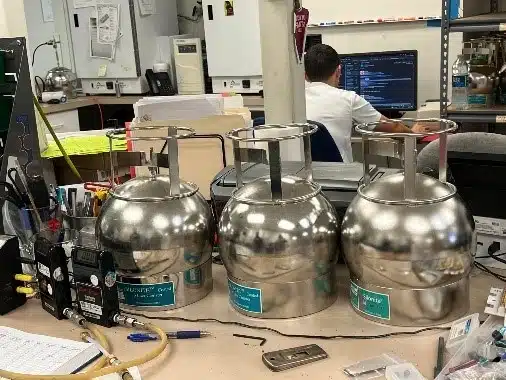Are you aware that the air inside your home can become more polluted than the air outside? Volatile Organic Compounds (VOCs) are usually the reason for this. Volatile Organic Compounds (VOC) are toxins that are released into the air that can endanger our health; surprisingly, many people are not aware of them being in their houses and workplaces. There are several household items or products from furniture to cleaning products that release VOCs in the rooms of your house or workplace. Performing inspections for VOC is the best option for identifying and eliminating these contaminants from your air. Removing these from your living areas will result in
improving both air quality and the overall well-being of yourself, your family, or employees.
What are VOCs?
Volatile organic compounds (VOC) which easily evaporate at room temperature are found in a variety of consumer goods, and emitted by gas stations and industrial operations contributing to air pollution levels. Humidity and temperature often can affect the presence of VOCs in the air. Higher temperatures and humidity can increase the rate of VOC emissions from specific materials. The presence of VOC such as acetone, benzene formaldehyde and toluene have been connected to health issues
Sources of VOCs
● Household Products: Paints and varnish, cleaning
products and air fresheners often contain VOCs that
can be released into the air.
● New Building Materials: New carpets and flooring
along with furniture and pressed wood items often
release organic compounds (VOC) such as
formaldehyde, into the air.
● New Office Equipment: New printers and copiers can
emit VOC like benzene or toluene, into the air.
● Outdoor Sources: Automobile emissions release VOCs that can seep into homes
through connected garages or open windows. Volatile organic compounds (VOC) are
released into the environment by processes as gas fumes, from petrol and emissions
from vehicles, on the road.

Specific Examples of VOCs and Their Health Effects:
- Formaldehyde: Known carcinogen, can cause eye, nose, and throat irritation, and respiratory problems.
- Benzene: Known carcinogen, can cause dizziness, headaches, and in severe cases, loss of consciousness.
- Toluene: Can cause neurological damage, headaches, and dizziness.
Importance of VOC Testing
VOC testing is crucial for several reasons:
1. Health Risks: Long-term exposure to VOCs has been linked to a plethora of health issues
including respiratory infections, headaches, dizziness, and even liver, kidney, or central nervous
system damage. At Quest we want to ensure your safety and health. VOC testing helps to
identify where your indoor air is most likely contaminated so that you can avoid possible health
risks.
2. Improved Indoor Air Quality: VOC testing enables you to identify the sources of
contamination in your indoor air. It could be due to new paint, new carpet, or extensive use of
cleaning chemicals. Addressing these sources can greatly impact the air quality and comfort of
a house or office.
3. Peace of Mind: If you do have concerns about indoor air pollution, Volatile Organic Compounds testing helps to provide peace of mind. Testing detects even the smallest traces of VOCs, giving you all the information that you need in order to take action and improve air quality for you and your family members’ health.
How Does VOC Testing Work?
VOC testing typically involves passive or active sampling:
– Passive Sampling: A collection device like a tube or badge is placed in the room for a
designated period of time to gather VOCs from the air. It is a rather simple process and can
usually be conducted by a homeowner or business owner.
– Active Sampling: Air is drawn through a sampling device with the help of a pump, which is then tested in an accredited laboratory. It gives more precise and specific readings of the VOC levels in your spaces so you can determine your next steps.
Depending on your needs, you can test for
individual VOCs or a broader range of chemicals. VOC testing is typically conducted by trained professionals who can identify VOC sources and recommend mitigation strategies. Cost ranges for testing vary; contact Quest for a quote

Reducing VOCs in Your Home
If testing for VOCs show elevated levels in your home, you can take these steps to help reduce
or eliminate them:
1. Ventilation: Increase the airflow in the space by opening windows or using exhaust fans. This
can help air out the contaminants.
2. Low-VOC Products: Choose paints, cleaners, and adhesives labeled as “low-VOC” or
“no-VOC.” Removing these products will increase the overall air quality.
3. Air Purifiers: Use air purifiers with activated carbon filters to capture VOCs in the air.
4. Natural Alternatives: Use natural cleaning solutions like vinegar and baking soda and opt for
]]]natural air fresheners like essential oil diffusers.
5. Regular VOC Testing: Test indoor air periodically, especially after renovations, bringing in new
furniture, or using new products.
VOC testing is a simple and effective way of maintaining your health and improving your living
environment. Monitoring and controlling VOC levels can save you and your family from the
harmful impacts of indoor air pollution, making your home more comfortable and healthier. If
you’re settling into a new home or concerned about indoor air quality, have VOC testing
performed to ensure that the air you breathe is safe and clean?
Don’t wait to breathe easier. Contact Quest Testing today for a comprehensive VOC test. We are licensed and insured and are here to help your family in times of need.


